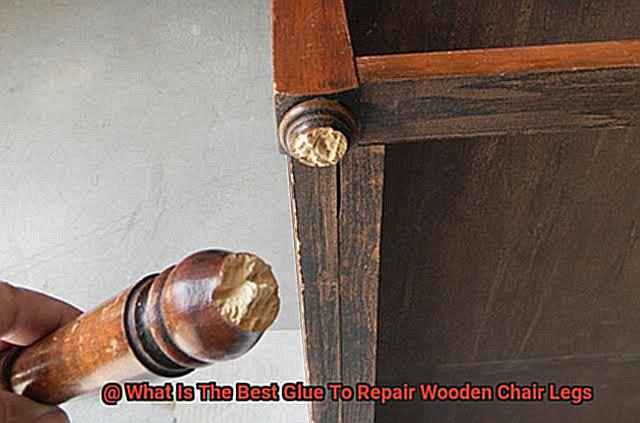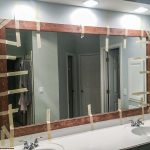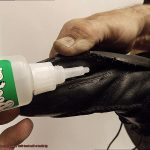Ever been on the brink of giving up on a wobbly wooden chair? Don’t toss it just yet.
There’s hope for your beloved seat, and it comes in the form of glue. Yes, you heard that right – glue can be the hero that saves your furniture from the abyss of redundancy.
But hold on tight because not all glues are created equal. Choosing the right adhesive to repair those creaky chair legs requires a little know-how.
In this blog post, we’ll unravel the mysteries of glue and dive into the fascinating world of chair leg salvation. So let’s get started and discover which glue is best for fixing those wobbly wooden legs.
Types of Glue for Wooden Chair Legs
Contents
- 1 Types of Glue for Wooden Chair Legs
- 2 Factors to Consider When Choosing the Best Glue
- 3 Advantages of Epoxy Resin
- 4 Advantages of Polyurethane Glue
- 5 Advantages of Super Glue
- 6 How to Properly Apply the Glue to Repair Wooden Chair Legs
- 7 Tips for Choosing the Right Glue for Different Types of Wood
- 8 Conclusion
Repairing wooden chair legs can be a simple and cost-effective way to extend the life of your favorite chair. However, choosing the right type of glue is crucial for a successful repair. In this guide, we will explore five different types of glue that are commonly used for repairing wooden chair legs.
Each type has its own unique properties and applications, ensuring that you can find the perfect glue for your specific repair needs.
Epoxy Resin
Step into the world of restoration and witness the transformation of your beloved wooden chair with the power of epoxy resin. In this comprehensive guide, we will explore the wonders of epoxy resin – a mighty adhesive that will breathe new life into your worn-out chair legs. Join us on this captivating journey as we uncover the advantages, limitations, and application methods of using epoxy resin for repairing wooden chair legs.
Advantages of Using Epoxy Resin:
- Gap-filling prowess: With its thick consistency, epoxy resin possesses the remarkable ability to seep deep into cracks and gaps in the wood, securing a bond that reinforces weak spots and prevents further damage.
- Defying the elements: Wooden chairs are exposed to various environmental conditions, from sweltering summers to damp winters. Fear not. Epoxy resin stands strong against moisture and temperature changes, ensuring your repaired chair legs withstand the test of time.
- Embracing diversity: From rugged oaks to delicate pines, epoxy resin forms an unyielding alliance with various wood types, creating a bond that guarantees stability and security for your repaired chair leg.
Limitations of Using Epoxy Resin:
- Surface readiness is key: To unlock the full potential of epoxy resin, proper surface preparation is paramount. A clean, dry, and contaminant-free wood surface lays the foundation for optimal adhesion and success.
- A challenge for intricate designs: While epoxy resin works wonders for most repairs, its application can be a bit more demanding when it comes to intricate designs or delicate carvings. Extra care and precision are required in such cases.
Application Methods:
Epoxy resin comes in two versatile forms: liquid and putty. The liquid form is perfect for filling cracks and gaps in the wood, while the putty form allows you to rebuild and reshape damaged areas. Before applying, ensure a thorough mix of the epoxy resin components in the correct proportions to activate the magical chemical reaction.
Polyurethane Glue
Wooden chair legs, with their elegance and charm, are prone to wear and tear over time. But fear not. There’s a superhero adhesive that can save the day – polyurethane glue. In this blog post, we will explore the remarkable properties and versatile uses of polyurethane glue when it comes to repairing your cherished wooden chair legs.
Versatility:
Polyurethane glue is a true chameleon, capable of bonding different materials together. Whether your chair is made from oak, mahogany, or pine, this glue can create a strong bond that stands the test of time. No matter the type of wood, polyurethane glue has got you covered.
Superior Bonding Strength:
When it comes to repairing fractured or completely broken chair legs, polyurethane glue reveals its super strength. It forms an unbreakable bond that ensures your repaired chair leg remains intact, allowing you to once again revel in the comfort and beauty of your favorite chair.
Gap-Filling Wonder:
Polyurethane glue is like a magician’s trick – it expands as it cures, filling in gaps and irregularities in the wood. This unique property guarantees a tight and secure bond, even in areas where surfaces may not align perfectly. Moreover, less glue is required compared to other adhesives, making it a cost-effective choice for repairs.
Waterproof Brilliance:
Imagine your wooden chair legs exposed to moisture or damp environments – a nightmare for most adhesives. But fear not. Polyurethane glue is waterproof once cured, ensuring that your repaired chair leg remains stable and durable under everyday use. Rain or shine, your chair will stand strong.
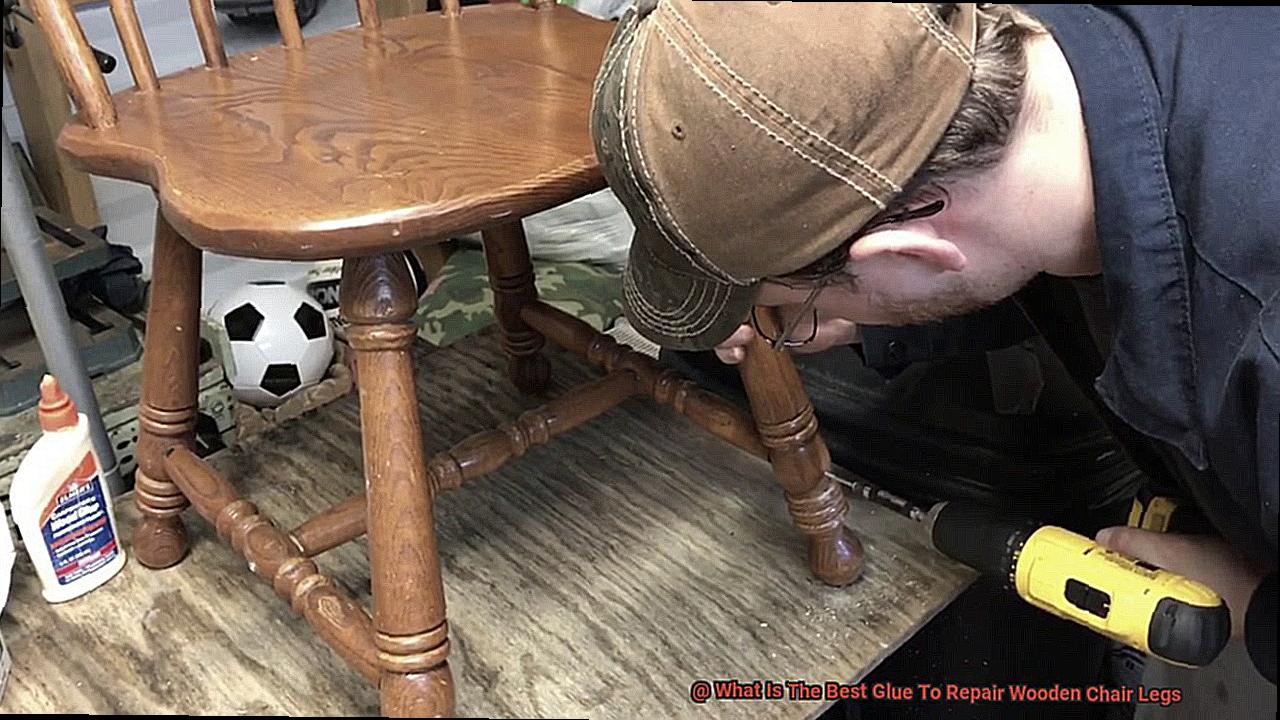
Cyanoacrylate (Super) Glue
I have the solution that will put an end to your chair leg woes – cyanoacrylate glue, better known as super glue.
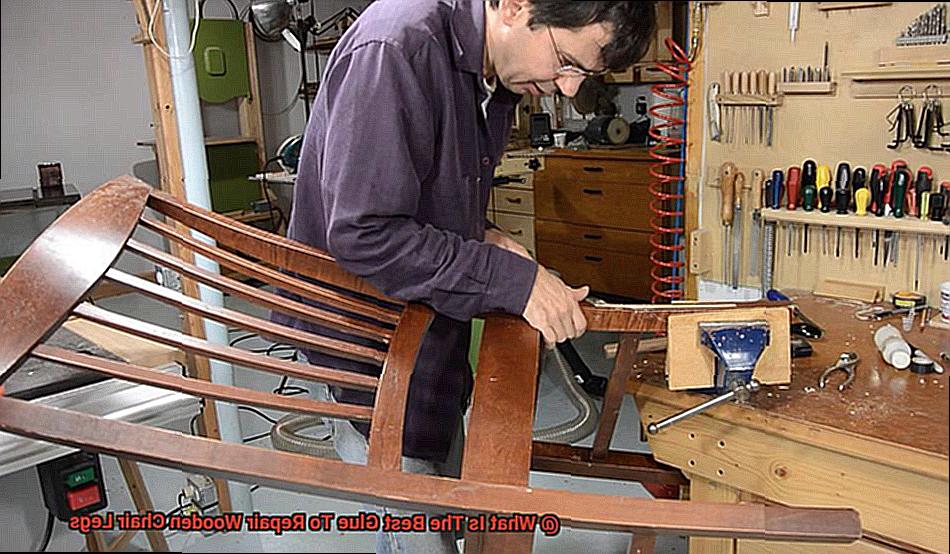
Super glue is the hero we need for our wooden chairs, and here’s why:
- Lightning-Fast Drying: Say goodbye to those agonizing waiting periods. With cyanoacrylate glue, you won’t have to twiddle your thumbs while waiting for the glue to dry. It dries in a flash, allowing you to get back to enjoying your sturdy chair in no time.
- Unbreakable Bond: When it comes to bonding, super glue means business. It forms an unyielding and trustworthy bond between surfaces, ensuring that your chair legs stay firmly in place. No more embarrassing falls or nerve-wracking wobbles during family dinners.
Now, let’s delve into the application techniques that will guarantee success:
- Clean and Dry Surfaces: Before embarking on your chair leg repair adventure, make sure to give those legs a thorough cleaning. Smooth out any rough spots by sanding them down and wipe away any dirt or dust. A clean surface is essential for achieving a strong bond.
- Squeeze and Press: Apply a small amount of super glue onto one surface of the wood and press the two pieces together firmly. Hold them in place for a few minutes to allow the glue to set properly. But be cautious. Avoid getting any glue on your skin, as it can bond skin together too.
But wait, there’s more. Super glue has another trick up its sleeve – durability. Once it has fully cured, it can withstand regular use and endure stress without faltering. So even if you have a rowdy bunch at home who loves to rock back and forth on their chairs, super glue has got your back.
However, it’s important to note that super glue may not be the best solution for all repairs. If your chair legs are severely damaged or have structural issues, it’s wise to consult a professional or explore alternative methods.
Factors to Consider When Choosing the Best Glue
When it comes to choosing the best glue for a particular project, such as repairing wooden chair legs, several key factors should be considered. These factors will determine the strength and durability of the bond, as well as the overall appearance of the finished project.
First and foremost, consider the type of wood that the chair legs are made from. Different types of wood have different properties and require specific types of glue. Porous woods like oak or pine will benefit from a glue that is specifically formulated for porous materials. On the other hand, if you’re dealing with hardwoods like mahogany or cherry, a stronger adhesive may be necessary to ensure a secure bond.
Next, think about the purpose of your chairs. If they’re purely decorative or rarely used, a less durable glue may suffice. However, if your chairs are subjected to heavy weight or stress on a regular basis, you’ll need a glue that can withstand the pressure. Look for glues that advertise high strength or are specifically designed for heavy-duty applications.
Consider the environment in which your chairs will be used. If they’ll be exposed to moisture or extreme temperature fluctuations, a waterproof or weather-resistant glue is essential. This will help ensure that your repairs remain strong and intact even in challenging conditions.
Ease of use is also important to consider. Some glues require mixing or special application techniques, while others come in convenient squeeze bottles or applicator pens. Consider your level of experience and comfort with different types of glues before making your choice.
Lastly, drying time and curing properties are vital considerations. Some glues dry quickly but require additional time to fully cure and reach their maximum strength. Others may have a longer drying time but offer a stronger bond once fully cured. Think about your timeline for completing the repair and choose a glue that aligns with your needs.
Advantages of Epoxy Resin
Allow me to introduce you to the superhero of the adhesive world – epoxy resin. This mighty glue is your secret weapon for transforming those shaky chair legs into sturdy pillars of support in no time at all.
So, what makes epoxy resin so special? Let’s dive into its advantages and discover why it’s the ultimate choice for repairing wooden chair legs.
First and foremost, let’s talk about strength. Epoxy resin creates a bond that can withstand the weight and stress applied to chair legs, ensuring a repair that will last for years to come. Say goodbye to the fear of your favorite chair collapsing during those intense family game nights.
But wait, there’s more. Epoxy resin boasts excellent adhesive properties. It sticks like a champ to both wood surfaces and other materials commonly found in chair construction. No more loose joints or unstable connections. With epoxy resin, you can enjoy a secure and reliable bond that enhances the overall stability of your chair.
Now, imagine this scenario: you’re sitting back, enjoying a cup of coffee in your newly repaired chair when disaster strikes – a spill. But don’t panic. Epoxy resin is water-resistant, forming a protective barrier against moisture. No more worrying about your chair legs swelling, warping, or rotting. Talk about peace of mind.
But the advantages don’t stop there – epoxy resin is also incredibly versatile. It comes in different formulations, allowing you to fine-tune its properties for your specific repair job. Whether you need it thicker or thinner, faster or slower drying time, epoxy resin has got your back.
Now, let’s talk about ease of use. Even if you’re not a woodworking expert, fear not. Epoxy resin is easy-peasy to use. Simply mix the two parts together, apply it to your chair leg components, and voila. You’ll have ample time for positioning and alignment before it sets. You’ll feel like a pro in no time.
And the benefits keep on coming. Once your epoxy resin has fully cured, it becomes sandable and paintable. This means you can achieve a smooth and seamless repair that blends perfectly with the rest of your chair. And if you want to get fancy, go ahead and paint it to match your chair’s original finish. The possibilities are endless.
Oh, and did I mention the long shelf life? Unlike some other adhesives, epoxy resin can be stored for a long time without losing its effectiveness. So even if you only need a small amount for your chair leg repair, you can keep the rest for future projects.
Advantages of Polyurethane Glue
Say goodbye to wobbly wooden chair legs and hello to sturdy seating with the superhero adhesive known as polyurethane glue. This remarkable glue possesses a range of advantages that make it the perfect choice for repairing those pesky chair legs.
First and foremost, polyurethane glue is renowned for its strong bond. When it comes to fixing wooden chair legs, you need a glue that can withstand the weight and pressure put on the legs. Polyurethane glue excels in this area, creating a durable bond that can endure heavy loads. No more creaking or groaning chairs.
But that’s not all – polyurethane glue is also water-resistant. Unlike some other glues that break down when exposed to moisture, polyurethane glue maintains its strength and integrity even when in contact with liquids. So, if your chair legs happen to come into contact with spilled drinks or damp environments, you can rest assured that the repair will hold strong.
Another advantage of polyurethane glue is its gap-filling properties. When repairing wooden chair legs, there may be small gaps or uneven surfaces that need to be filled for a strong and seamless repair. Polyurethane glue expands slightly as it cures, allowing it to fill in any gaps and create a solid bond between the pieces being repaired. This ensures that your chair legs are not only secure but also stable.
What sets polyurethane glue apart from other adhesives is its versatility. It can be used on various materials, including wood, metal, plastic, and more. So, whether you need to mend a broken piece of furniture or fix a household item made from different materials, polyurethane glue has got you covered.
Lastly, let’s talk about the long shelf life of polyurethane glue. Unlike some other glues that dry out quickly once opened, polyurethane glue has a relatively long shelf life. This means you can keep it in your workshop for an extended period without worrying about it becoming ineffective. So, whenever you need to repair your wooden chair legs or any other items, you’ll have the trusty polyurethane glue ready to go.
Advantages of Super Glue
Fear not. The mighty super glue is here to save the day. With its incredible benefits, super glue is the perfect choice for repairing those troublesome chair legs. In this article, we will explore the advantages of using super glue, including its strong and fast bonding, versatility, ease of use, ability to create invisible repairs, and resistance to water and heat.
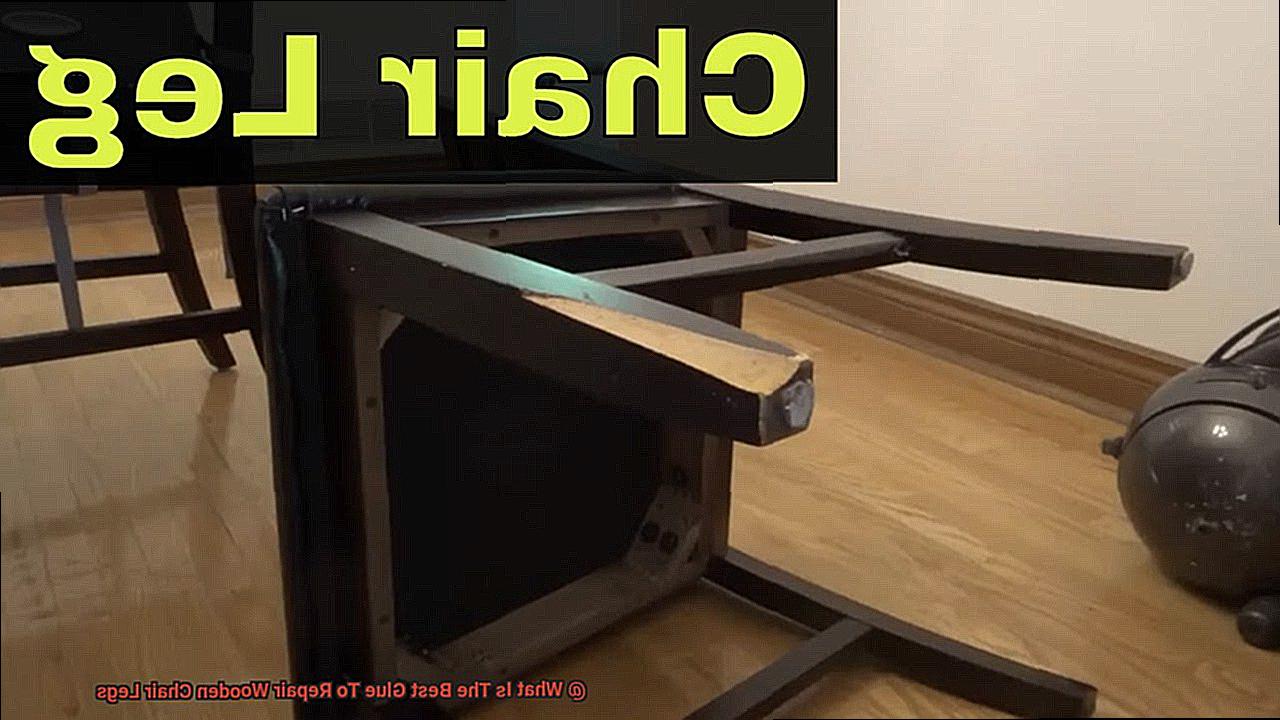
Advantage #1: Strong and Fast Bonding
Super glue is renowned for its incredible bonding strength. It forms an unbreakable bond between surfaces, ensuring a durable and long-lasting repair for your wooden chair legs. But what sets it apart is its speed. Super glue bonds quickly, often within seconds. No more waiting for hours or days for the glue to dry – with super glue, your chair legs will be back in action in no time.
Advantage #2: Versatility
Super glue is a versatile adhesive that can bond various materials together. Whether you need to fix a wooden chair leg, mend a broken vase, or repair a plastic component, super glue can come to the rescue. Its ability to bond different materials makes it an essential tool for any DIY enthusiast or professional. No need to buy separate glues for different projects – super glue has got you covered.
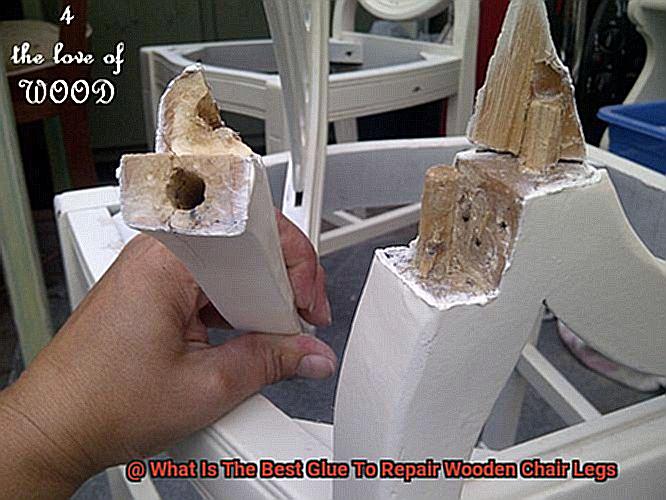
Advantage #3: Ease of Use
One of the greatest advantages of super glue is how easy it is to use. Applying super glue is a straightforward process – just apply a small amount of glue to the surfaces you want to bond, press them together firmly, and hold them in place for a few seconds. The glue sets quickly, eliminating the need for clamps or other holding mechanisms in most cases. It’s simple, hassle-free, and perfect for quick fixes.
Advantage #4: Invisible Repairs
Nobody wants unsightly repairs on their beloved wooden chairs. That’s where super glue shines – it creates nearly invisible repairs. Unlike other glues that may leave visible residue or require additional finishing work, super glue creates a clean and clear bond line. Your repaired chair legs will blend seamlessly with the rest of the chair, leaving no trace of the repair. Say goodbye to eyesores and hello to flawless repairs.
Advantage #5: Water and Heat Resistance
Wooden chair legs can be exposed to spills or damp environments, but super glue is up to the challenge. Once it has fully cured, super glue forms a waterproof bond that can withstand exposure to moisture without deteriorating or weakening. Additionally, super glue can also withstand high temperatures, ensuring the repair remains intact even under heat stress. Your repaired chair legs will be ready to face whatever challenges come their way.
How to Properly Apply the Glue to Repair Wooden Chair Legs
With the right technique and glue, you can easily repair it and bring it back to its former glory. In this blog post, we will guide you through the proper steps to apply glue and repair wooden chair legs.
Clean and Prepare the Surfaces:
To ensure a strong bond between the wood and the glue, it is crucial to clean and prepare the surfaces that need to be bonded. Take a brush or cloth and meticulously remove any remnants of old glue, dirt, or debris. This step is essential for a successful repair.
Choose the Right Glue:
Selecting the appropriate type of glue is vital for an effective repair. Wood glue is often the go-to choice as it is specifically designed for bonding wood surfaces. It provides a strong bond and is easy to work with. If you need extra strength, epoxy adhesive is an excellent option, while super glue works well for smaller repairs.
Do a Test Fit:
Before applying the glue, do a test fit of the broken pieces. This will help you ensure that they fit together properly and allow you to identify any alignment issues that need to be addressed before applying the glue.
Apply the Glue:
Take a small brush or toothpick and evenly spread a thin layer of glue onto one of the surfaces that need to be bonded. Be careful not to apply too much glue as excess squeeze-out can create a messy situation. Make sure to cover the entire area evenly for a secure bond.
Press Firmly and Hold in Place:
Press the broken pieces together firmly and hold them in place for a few minutes to allow the glue to set. Applying even pressure is crucial for a strong bond. If needed, use clamps or rubber bands to keep the pieces in place during the drying process.
Remove Excess Glue:
Once the glue has dried completely, usually within 24 hours, carefully remove any excess glue that may have squeezed out. Use a scraper or sandpaper to give the repaired leg a smooth and clean finish.
Tips for Choosing the Right Glue for Different Types of Wood
Repairing chair legs can be a challenging task, especially when it comes to selecting the right glue. However, with the right knowledge and understanding of different wood types and glues, you can ensure a strong and long-lasting bond. In this guide, we will provide you with valuable tips on how to choose the perfect glue for different types of wood when repairing chair legs.
Assess the Wood Type:
The first step in selecting the right glue is to consider the type of wood you are working with. Softwoods like pine or cedar have open pores that readily absorb glue, making them compatible with most types of adhesive. However, hardwoods like oak or mahogany have tighter grain patterns and require a glue that can penetrate deeper into the wood for a secure bond.
Evaluate Project Requirements:
Consider the specific requirements of your project. If you’re repairing chair legs that endure constant stress and movement, opt for a strong adhesive like epoxy resin or polyurethane glue. These glues provide exceptional strength and durability, ensuring your repaired chair legs can withstand heavy use without compromising stability.
Know Your Glue Options:
There are several types of glues available, each with its own unique characteristics. Yellow PVA glue is popular for general woodworking applications and works well with both softwoods and hardwoods. Polyurethane glue expands as it cures, filling gaps and creating a strong bond, making it an excellent choice for repairing chair legs. Epoxy resin offers superior strength and resistance to moisture, heat, and chemicals, making it perfect for outdoor furniture or projects exposed to harsh conditions. Cyanoacrylate glue, also known as super glue, is fast-setting and ideal for small repairs or precision work.
Consider Application Method:
The way in which you apply the glue can impact your choice as well. Squeeze bottles, liquid forms, or adhesive tapes all have their advantages. Consider the accessibility of the repair area and choose a glue that allows for easy and precise application.
Conduct a Test:
Before committing to a specific glue, it’s always wise to test it on a small, inconspicuous area of the wood. This will help you evaluate its bonding strength, drying time, and compatibility with the wood type.
Conclusion
When it comes to repairing wooden chair legs, choosing the right glue is crucial.
You want a glue that will not only bond the pieces together securely but also withstand the test of time. After careful research and consideration, I can confidently say that epoxy resin is the best glue for this task.
Its strong adhesive properties make it ideal for repairing wooden chair legs, ensuring a long-lasting and durable fix.

